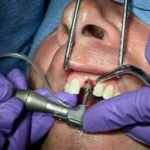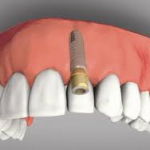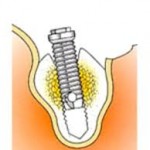This innovative technique is revolutionizing the way people around the world receive dental implants. Dental implants are definitely the best option to help those with missing teeth. However, traditional implants are expensive and a very time consuming process often taking from 6 to 18 months to complete with multiple surgeries. With same day implants you will not have to wait 2 to 6 months until you have teeth. On the day of your implant surgery you will leave the office with a temporary crown attached to your implant. One month later the permanent crown can be attached.
This technique can be used in the following situations
- Single tooth replacement
- Multiple tooth replacement
- On the same day as extraction(s)
- Secure your existing dentures
Other than the dental implant cost, what is the difference between same day implants and traditional implants?
 In brief traditional implants consist of the following steps:
In brief traditional implants consist of the following steps:
- First surgery-oral surgeon exposes the jaw bone and drills a 6 to 7mm hole to insert a 4mm titanium post.
- Waiting time of approximately 2 to 6 months until your bone grows around the post.
- Second surgery-oral surgeon exposes the tip of each post and attaches the crown.
- If a bone graft is needed another  surgery would be needed before inserting the titanium post adding another 4 to 8 months of healing time. This is very common as traditional implants can only be inserted vertically.
Same day dental implant method
Under a light pain medication such as Ibuprofen and local anesthesia, the doctor will drill a 2.25 mm hole through the gum and jaw bone and insert a 4mm titanium post that is very similar to a screw. The implant is placed and tested with a torque wrench to see if it can be displaced with a force of 40 ncm. Next we customized a zirconium abutment and attach it to the implant with a torque of 35 ncm.
One of the advantages of using a white zirconium abutment as opposed to the silver colored titanium is that there is no graying of the overlying gum tissue.
 Zirconia products have become established as a product of choice for creating abutments, fixed bridgework and other cosmetic restoration products that overcomes the problem of metallic colorations showing through. An immediate post operative x-ray is taken to show the implant, zirconium abutment and temporary crown. Once the post has been inserted she will place a temporary tooth on the post. Usually the process takes about 15 to 20 minutes. The inserted titanium post is very secure from the beginning but for the first month it is important to take care of the temporary tooth by not eating foods such as raw carrot, apples etc to allow the bone to fully attach to the post.
Zirconia products have become established as a product of choice for creating abutments, fixed bridgework and other cosmetic restoration products that overcomes the problem of metallic colorations showing through. An immediate post operative x-ray is taken to show the implant, zirconium abutment and temporary crown. Once the post has been inserted she will place a temporary tooth on the post. Usually the process takes about 15 to 20 minutes. The inserted titanium post is very secure from the beginning but for the first month it is important to take care of the temporary tooth by not eating foods such as raw carrot, apples etc to allow the bone to fully attach to the post.
In 30 days you can have your permanent crown in place. The permanent crown will be made of porcelain material, which will be matched precisely with the patient’s existing teeth.
With tramonte implants if there is insufficient bone directly above the missing tooth. The implant can be set at an angle and relieve the need for bone grafting.
Immediate Load Implant Criteria
To do an immediate load implant, certain criteria have to be met. There has to be adequate bone, a large enough implant needs to be placed, and the implant once placed has to be able to resist at least 40 ncm of force.
The temporary crown has to be adjusted so that no forces are placed on it during function. Meeting these criteria allows the bone to grow around the implant (osseointegration). After a period of nine weeks a permanent crown can placed.
A template was made of the tooth prior to removing the fractured cusp so as to facilitate fabrication of a temporary crown.
An important factor in this procedure is to carefully remove the tooth without removing any bone in the process.
With same day implants, you can say goodbye to….
- Multiple visits to the dentist’s office for measurements, drilling, and surgeries
- Months of healing time and associated pain
- Pain from ill-fitting dentures
- Problems chewing food
Success rates
Dental implant success is related to operator skill, quality and quantity of the bone available at the site, and the patient’s oral hygiene. The consensus is that implants carry a success rate of around 95%.
One of the most important factors that determine implant success is the achievement and maintenance of implant stability. The stability is presented as an ISQ (Implant Stability Quotient) value. Other contributing factors to the success of dental implant placement, as with most surgical procedures, include the patient’s overall general health and compliance with post-surgical care.
Failure
Failure of a dental implant is often related to the failure of the implant to osseointegrate correctly with the bone, or vice-versa. A dental implant is considered to be a failure if it is lost, mobile or shows peri-implant (around the implant) bone loss of greater than 1.0 mm in the first year and greater than 0.2 mm a year after.
Dental implants are not susceptible to dental caries but they can develop a condition called peri-implantitis. This is an inflammatory condition of the mucosa and/or bone around the implant which may result in bone loss and eventual loss of the implant. The condition is usually, but not always, associated with a chronic infection. Peri-implantitis is more likely to occur in heavy smokers, patients with diabetes, patients with poor oral hygiene and cases where the mucosa around the implant is thin.
Currently there is no universal agreement on the best treatment for peri-implantitis. The condition and its causes is still poorly understood.
Risk of failure is increased in smokers. For this reason implants are frequently placed only after a patient has stopped smoking as the treatment is very expensive. More rarely, an implant may fail because of poor positioning at the time of surgery, or may be overloaded initially causing failure to integrate. If smoking and positioning problems exist prior to implant surgery, clinicians often advise patients that a bridge or partial denture rather than an implant may be a better solution.
Failure may also occur independently of the causes outlined above. Implants like any other object suffers from wear and tear. If the implant(s)in question are replacing commonly used teeth, then these may suffer from wear and tear and after years may crack and break up, although this is a very rare occurrence. The only way to minimize the risk of this happening is to visit your local dentist for regular reviews.
In the majority of cases where an implant fails to integrate with the bone and is rejected by the body the cause is unknown. This may occur in around 5% of cases. To this day we still do not know why bone will integrate with titanium dental implants and why it does not reject the material as a ‘foreign body’. Many theories have been postulated over the last five decades. A recent theory argues that rather than being an active biological tissue response, the integration of bone with an implant is the lack of a negative tissue response. In other words, for unknown reasons the usual response of the body to reject foreign objects implanted into it does not function correctly with titanium implants. It has further been postulated that an implant rejection occurs in patients whose bone tissues actually react as they naturally should with the ‘foreign body’ and reject the implant in the same manner that would occur with most other implanted materials.

